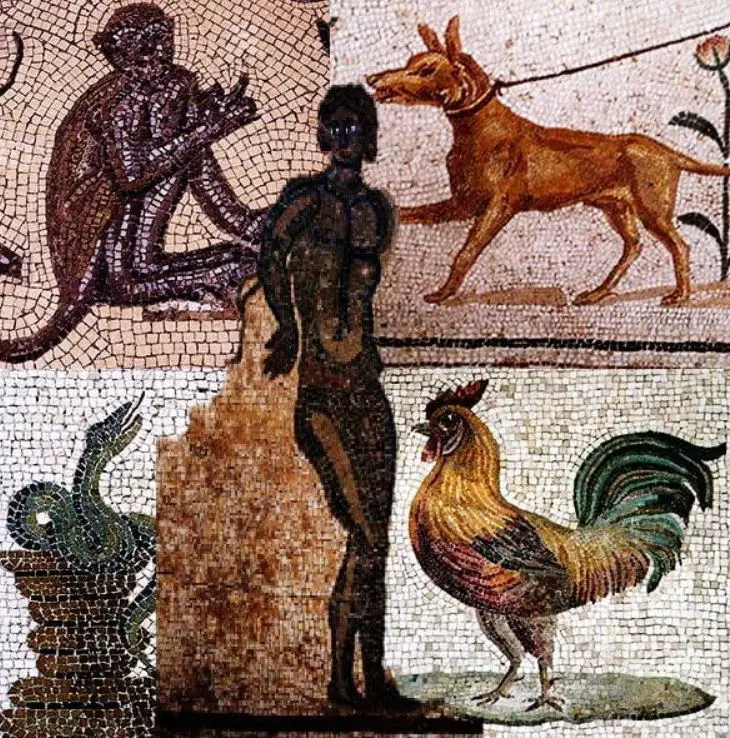What happens when you put a condemned criminal, a dog, a monkey, a snake, and a rooster into a sack and throw it in a river? This is not the start of some sick joke, because, in Ancient Rome, this question could actually be answered for real!
Let’s take a closer look at some fascinating facts about Poena Cullei, a horrible way to meet your end in the Roman World!
A Sack, the condemned, and some animals
Poena Cullei was a legal form of capital punishment under Roman law for people who committed parricide or matricide. This crime revolved around killing your own father or mother, or somebody who acted as your father or mother (like a stepfather or stepmother).
The name of the capital punishment method literally translates from Latin to “Punishment of the Sack,” this is for the simple reason that it involved sewing the condemned criminal into a leather sack and throwing the whole ensemble into the water.

The details may have varied a bit
This form of capital punishment allowed for some creativity. There was the usual whipping before the parricide was put into the ox-leather bag, but the choice of animals wasn’t always clear.
The first mention of this particular form of the death penalty was made around 90 B.C., and the first time live animals were mentioned was during the early Roman Empire. There was, however, only a mention of snakes that were included in the sack back then.
To ensure the execution was successful, a bag was put over the condemned’s head and wooden shoes were put on his feet.
The sack was most probably huge
What’s remarkable about Poena Cullei is that the sack used was in fact enormous. According to one historian, the sack used for the execution was the same as those being used to transport wine. These sacks were not only water-proof but also had a volume of about 547 liters, which is the equivalent of 144.5 US gallons.
This means that there was plenty of space to move around and more importantly, enough air to survive long enough to suffer the consequences of wild animals going mental while floating around in the river or sea.
Then again, this was obviously the intention of the wicked lawmakers who conceived this horrible execution method.
This animal combo seemed to be the most popular
The Romans were particularly fond of humiliating the condemned and making him/her suffer as much as possible. After experimenting for a few hundred years with this execution method, they seemed to have established the perfect animal combo to be included in the sack.
During the reign of Emperor Hadrian in the first half of the 2nd century A.D. (118-137), a particular case was described which went into full detail about Poena Cullei. The included animals back then were a rooster, a dog, a monkey, and a viper (an extremely venomous snake).
We can only imagine what happened when they were thrown into the water together!

The condemned had 2 equally horrible choices
Once a person was convicted of parricide and sentenced to death, he had two choices, and needless to say, both options weren’t that great. Either the condemned had the choice to be sewn into a sack with wild animals and thrown into the water, or he had the alternative option to be thrown to the wild beasts in the arena.
While both options served their purpose as a form of entertainment for the Roman citizens, both were equally horrible for the condemned. You didn’t want to be part of either of these shows, that’s for sure!
The sack was replaced with fire during the Byzantine Empire
Being sewn into a sack and thrown into the sea was the legal punishment for parricides for most parts of the Roman Empire. At some points, it was more popular than other forms of capital punishment depending on the level of cruelty of the emperor.
Emperor Augustus (27 B.C.–14 A.D.) was way more lenient than, for example, Emperor Claudius (41-54 A.D.), a man who reportedly “sewed more men into the sack in five years than history says were sewn up in all previous centuries, resulting in more cullei than crucifixions.”
The punishment of the sack completely lost its appeal during the Byzantine Empire and was abolished in the law code of the “Basilica,” a set of laws that were completed in the year 892 A.D.
So what was the punishment for people who killed their own parents or close relatives from then on?
Being thrown to the flames, not exactly a great alternative as well…
The revival of the sack happened in Germany
Every once in a while, lawmakers get nostalgic about the good old days. This is exactly what happened during the Late Middle Ages in Germany when the punishment of the sack appeared to have experienced a revival in some parts in the 13th and 14th centuries.
There were some differences, though, because monkeys and snakes weren’t readily available so they were replaced with something else. The snake was replaced with a picture of a serpent and the monkey was replaced with a cat.
The most important difference was the sack, which was made out of linen instead of leather. This means it wasn’t waterproof so the condemned (and animals) died relatively quickly of drowning instead of suffocation in the leather sack.
The last case happened not that long ago
Perhaps one of the most remarkable facts about Poena Cullei is that the final reported cases in Saxony happened in the 18th century. The six final cases reportedly happened in the Saxonian city of Zittau between 1712 and 1749.
The condemned was put into a black sack and drowned together with a non-venomous colubrid snake while choir boys were singing a Lutheran Hymn called “Aus tiefer Not Schrei ich Zu dir” (From deep affliction I cry out to you).
This horrific form of the death penalty was eventually abolished in Saxony on June 17, 1761, and it was about time!
